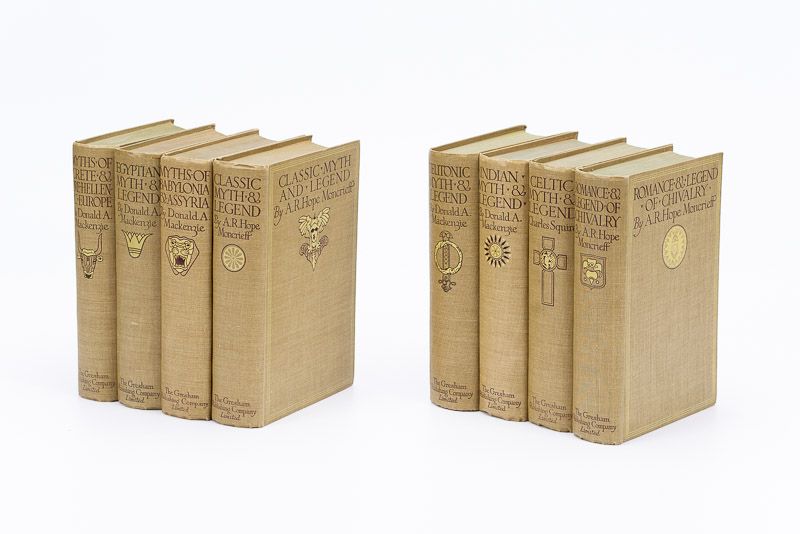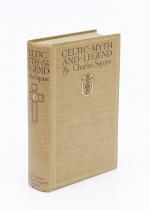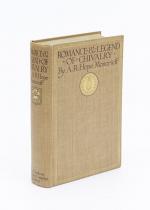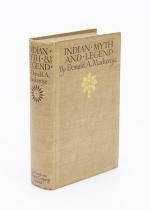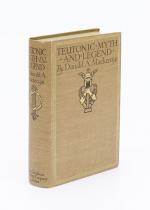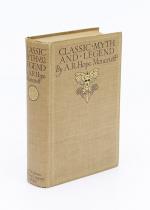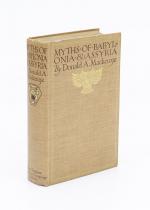Squire, Celtic Myth & Legend / Indian Myth & Legend / Myths of Babylonia & Assyr
Celtic Myth & Legend / Indian Myth & Legend / Myths of Babylonia & Assyria / Classic Myth & Legend / Romance & Legend of Chivalry / Teutonic Myth and Legend / Egyptian Myth and Legend / Myths of Crete and Pre-Hellenic Europe /
Eight volumes. London, Gresham Publishing, c. 1910-1918. 14.5 cm x 22 cm. Celtic Myth & Legend: XIV, 450 pages / Indian Myth & Legend: XLVIII, 463 pages / Myths of Babylonia & Assyria: XXXIX, 537 pages / Classic Myth & Legend: XVI, 443 pages / Romance & Legend of Chivalry: XII, 439 pages / Teutonic Myth & Legend: 469 pages / Egyptian Myth & Legend: 404 pages / Myths of Crete & Pre-Hellenic Europe: LIV, 361 pages // Original Hardcovers decorated with Celtic symbols in black and gilt on green boards. With Illustrations in Colour and Monochrome. This set in unusually excellent good condition with only minor signs of external wear. [Myth and Legend in Literature and Art].
Celtic Myth & Legend / Indian Myth & Legend / Myths of Pre-Columbian America / Myths of China & Japan / Myths of Babylonia & Assyria / Classic Myth & Legend / Romance & Legend of Chivalry.
Mythology can refer to the collected myths of a group of people—their collection of stories they tell to explain nature, history, and customs or to the study of such myths.
As a collection of explanatory stories, mythology is a vital feature of every culture. Many sources for myths have been proposed, ranging from personification of nature or personification of natural phenomena, to truthful or hyperbolic accounts of historical events to explanations of existing rituals. Although the term is complicated by its implicit condescension, mythologizing is not just an ancient or primitive practice, as shown by contemporary mythopoeia such as urban legends and the expansive fictional mythoi created by fantasy novels and comics. A culture’s collective mythology helps convey belonging, shared and religious experiences, behavioral models, and moral and practical lessons. The study of myth dates back to ancient history. Rival classes of the Greek myths by Euhemerus, Plato, and Sallustius were developed by the Neoplatonists, and later revived by Renaissance mythographers. The nineteenth-century comparative mythology reinterpreted myth as a primitive and failed counterpart of science (E. B. Tylor), a “disease of language” (Max Müller), or a misinterpretation of magical ritual (James Frazer). Recent approaches have rejected conflict between the value of myth and rational thought, often viewing myths as expressions to understand general psychological, cultural, or societal truths, rather than as inaccurate historical accounts. In modern society, myth is often regarded as historical or obsolete. Many scholars in the field of cultural studies are now beginning to research the idea that myth has worked itself into modern discourses. Modern formats of communication allow for widespread communication across the globe, thus enabling mythological discourse and exchange among greater audiences than ever before. Various elements of myth can now be found in television, cinema, and video games. (Wikipedia).
- Keywords: America · Assyrien · Babylon · Celtic Mythology · Chinese Culture · Cultural History – Rare · History – Rare · Indian and Hindu-Inspired Tales · Japanese Mythology · Library Set Rare · Mythology & Folklore Rare · Romance
- Language: English
- Inventory Number: 31340AB
EUR 1.400,--
© 2025 Inanna Rare Books Ltd. | Powered by HESCOM-Software





